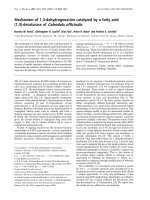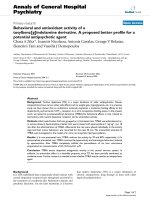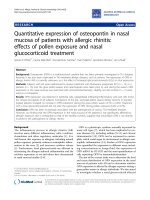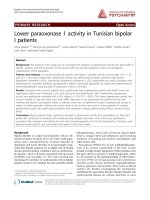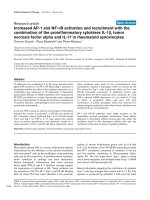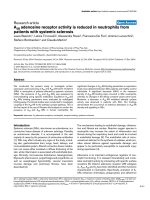Báo cáo y học: "Lower paraoxonase 1 activity in Tunisian bipolar I patients" pptx
Bạn đang xem bản rút gọn của tài liệu. Xem và tải ngay bản đầy đủ của tài liệu tại đây (603.44 KB, 6 trang )
PRIMARY RESEARCH Open Access
Lower paraoxonase 1 activity in Tunisian bipolar
I patients
Asma Ezzaher
1,2*
, Dhouha Haj Mouhamed
1,2
, Anwar Mechri
2
, Manel Araoud
1
, Fadoua Neffati
1
, Wahiba Douki
1,2
,
Lotfi Gaha
2
, Mohamed Fadhel Najjar
1
Abstract
Background: The purpose of this study was to investigate the variations of paraoxonase activity and lipid profile in
bipolar I patients, and the association of this activity with the sociodemographic, clinical and therapeutic
characteristics of this population.
Patients and methods: Our study included 66 patients with bipolar I disorder and 64 controls aged 37.9 ± 12.6
and 36.3 ± 18.2 years, respectively. Paraoxonase activity was determined by kinetic methods; high-density
lipoprotein cholesterol (c-HDL), low-density lipoprotein cholesterol (c-LDL), triglycerides and total cholesterol were
determined by enzymatic methods; apolipoprotein (Apo)A1, ApoB and lipoprotein (a) (Lp(a)) were determined by
immunoturbidimetry using Konelab 30 equipment (Thermo Scientific).
Results: Compared with controls, patients had a significantly lower paraoxonase activity and ApoA1 level, and
significantly higher total cholesterol, c-LDL and Lp(a) level and ApoB/ApoA1 ratio. Furthe rmore, paraoxonase
activity was significantly correlated with c-HDL values (r = 0.5612; P < 0.001). The lowest paraoxonase activity was
noted in relation to age and body mass index (BMI). Moreover, it was associated with gender but not with
smoking and alcohol consumption status. In patients, there was no significant change in paraoxonase activity in
relation to illness episodes, whereas the lowest values of this activity were seen in manic patients. In contrast,
paraoxonase activity was significantly associated with treatment. Indeed, patients taking lithium had the lowest
levels.
Conclusions: Bipolar patients had a significant decrease in paraoxonase activity and perturbations in their lipid
profile that contribute to increased risk of cardiovascular diseases. Decrease in this activity was significantly
associated with treatment with lithium but not with sociodemographic and clinical characteristics. Therefore, such
patients require specific care, particularly with regard to their lipid profile.
Background
Bipolar disorder is a major mood disorder, with an esti-
mated prevalence of about 1% to 3% of the world popu-
lation, and is characterised by recurrent e pisodes of
depression and mood elevation. It is increasingly recog-
nised that bipolar patients are at higher risk of having
chronic general medical conditions such as ca rdiovascu-
lar disease, which is directly associated with increased
morbidity and mortality [1]. The exact mechanisms
increasing the incidence of cardiovascular risk in bipolar
patients remain to be clarified, but t hey possibly include
industrialisation, stress, lack of exercise, dietary lipids
(that is, omega-3 fatty acid deficiency) and increasing
incidence of smoking and alcohol consumption and
other factors [2,3].
Paraoxonase ((PON) (EC 3.1.8.1) aryldialkylphospha-
tase) is an enzyme synthesised in the liver, mostly
located on high-density lipoprotein (HDL) particles, that
has been shown to protect or inhibit lipoprotein, which
is a key process in the pathophysiology of atherosclero-
sis [4,5]. PON1 exerts paraoxonase and arylesterase
activities as the enzyme hydrolyses organophosphates
(such as paraoxon) and aromatic esters (such as phenyl
acetate) [6]. Studies investigating the mechanisms
underlying the association between bipolar disorder and
cardiovascular disease are critical, and there is scant
* Correspondence:
1
Laboratory of Biochemistry-Toxicology, Monastir University Hospital, Tunisia
Full list of author information is available at the end of the article
Ezzaher et al. Annals of General Psychiatry 2010, 9:36
/>© 2010 Ezza her et al; licensee BioMed Central Ltd. This is an Open Access article distributed under the terms of the Creative Commons
Attribution Lic ense (http://creativec ommons.org/licenses/by/2.0), which permits unrestricted use, distri bution, and reproduction in
any medium, provided the original work is properly cited.
info rmation on the association between this disease and
PON1.
This study aims to investigate both the variations of
paraoxonase activity and lipid profile in bipolar I
patients and the association of this activity with the
sociodemographic, clinical and therapeutic characteris-
tics of this population.
Methods
Subjects
This study was approved by the local ethical commi tte e
and all subjects were of Tunisian origin. Our sample
included 66 bipolar I patients from the psychiatry
department of the Teaching Hospital of Monastir. The
mean age was 37.9 ± 12.6 years, 20 women (37.9 ± 14.3
years) and 46 men (37.9 ± 12.0 years). Consensus on the
diagnosis, according to the Diagnostic and Statistical
Manual of Mental Disorders, fourth edition (DSM-IV)
criteria [7], was made by psychiatrists. The exclusion
criteria were age (< 18 years), other ps ychiatric illnesses,
epilepsy or mental retardation. The control group con-
sisted of 64 volunteer subjects without psychiatric or
endocrinological diagnoses. The mean age was 36.3 ±
18.2 years, and there were 30 women (41.8 ± 17.3 years)
and 34 men (31.4 ± 17.9 years).
All subjects were questioned about their age, gender,
previous treatments and cigarette and alcohol consump-
tion habits. The clinical and sociodemographic charac-
teristics a re shown in Table 1. Differences between
patients and controls for gender, body mass index (BMI)
and alcoholic beverage consumption are noted. There-
fore, these variables were considered as potential con-
founder factors for this analysis.
Samples
After a 12 h overnight fasting, venous blood for each
patient was drawn in tubes containing lithium hepari-
nate and immediately centrifuged. The plasma samples
were stored at -20°C until the biochemical analysis.
Biochemical analysis
Paraoxonase activity was determined by kinetic methods
using paraoxon as substrate, concentrations of total cho-
lesterol, triglycerides, low-density protein cholesterol (c-
LDL) and HDL cholesterol (c-HDL) were determined by
enzymatic methods, and apolipoprotein (ApoA1, ApoB)
and lipoprotein (a) (Lp(a)) levels were determined by
immunoturbidimetric techniques using Konelab 30
equipment (Thermo Electron Corporation, Ruukintie,
Finland).
Clinical evaluations
BMI was calculated as weight (kg) divided by height
(m
2
). Obesity was defined when BMI ≥30 kg/m
2
[8].
Statistical analysis
Statistical analyses were performed using SPSS v. 17.0
(SPSS, Chicago, IL, USA). Quantitative variables were
Table 1 Sociodemographic and clinical characteristics of the sample population
Bipolar I patients (n = 66) Control group (n = 64) P value
Gender, male/female (ratio) 46/20 (2.30) 34/30 (1.13) 0.071
Age, years ± SD 37.9 ± 12.6 36.3 ± 18.2 0.550
BMI, kg/m
2
± SD 26.66 ± 4.46 24.88 ± 4.03 0.018
Cigarette smoking
Smokers 34 (51.5) 28 (43.8) 0.387
Non-smokers 32 (48.5) 36 (56.2)
Alcoholic beverages
Consumers 7 (10.6) 14 (21.9) 0.098
Non-consumers 59 (89.4) 50 (78.1)
Episode of illness
Depressive (D) 6 (9.1) - -
Euthymic (E) 42 (63.6) - -
Manic (M) 18 (27.3) - -
Treatment:
Valproic acid 31 (47.0) - -
Lithium 5 (6.7) - -
Carbamazepine 8 (12.1) - -
Antipsychotics 22 (33.3) - -
All values are n (%) unless otherwise stated.
BMI = body mass index.
Ezzaher et al. Annals of General Psychiatry 2010, 9:36
/>Page 2 of 6
presented as mean ± SD and comparisons were per-
formed using the Student’s t test. Qualitative variable
comparisons were performed using the Χ
2
test. Compar-
isons between patients and controls in paraoxonase
activity and lipid profile were performed using analysis
of variance (ANOVA) after adjustment for potential
confounder factors (gender, BMI and alcoholic beverage
consumption). The statistical significance level w as set
at P < 0.05.
Results
Compared with control subjects, bipolar I patients had
significantly lower paraoxonase activity and ApoA1
levels, and significantly h igher values for total choles-
terol, c-LDL, ApoB, ApoB/ApoA1 ratio and Lp(a) (Table
2). Furthermore, paraoxonase activity was significantly
correlated with c-HDL values (r = 0.5612; P < 0.001)
(Figure 1).
After adjustment of paraoxonase activity and lipid
profile for confounder factors, we noted a significant
association between bipolar disorder and low p araoxo-
nase activity (P < 0.0001), low ApoA1 values (P <
0.0001) , hypercholesterolaemia (P < 0.0001), high c-LDL
values (P < 0.0001), high ApoB/ApoA1 ratio (P <
0.0001) and high Lp(a) values (P < 0.0001), but no sig-
nificant association was observed with ApoB (P = 0.07)
values (Table 3).
We found that paraoxonase activity was significantly
lower in both male and female patients compared to
control subjects of the same gender. Moreover, in
patients, this parameter was less in men than women.
The lowest paraoxonase activity was noted in patients
compared to controls regardless of age and BMI (Table
3). In patients, the least paraoxonase activity was found
in subjects with BMI values below 25 kg/m
2
;andthose
aged more than 60 years (Table 3).
Paraoxonase activity was significantly lower in both
smoking and non-smoking patients compared to
controls with the same smoking status. In patients, non-
smokers had lower values of this parameter than smo-
kers (Table 3).
With regard to alcohol consumption status, for non-
consumers patients had significantly lower values of
paraoxonase activity than controls. Moreover, they had
lower values t han patients who consumed alcohol
(Table 3).
In patients, there was no significant change in paraox-
onase activity in relation to illness episodes. However,
manic patients had lower mean values of paraoxonase
activity than others (Table 3). We also showed that this
activity was significantly associated with the treatment.
Indeed, patients taking lithium had the lowest levels of
this parameter (Table 3).
Discussion
Bipolar patients had significantly lower paraoxonase
activity than control subjects. These alterations in the
plasma paraoxonase activity levels could be one of the
missing factors in understanding the relationship
between psychiatric disorders and increased cardiovas-
cular risk. In fact, some studies have reported that psy-
chiatric disorders, particularly bipolar disorder, are
significantly associated with adverse cardiovascular
events and coronary heart disease [9].
The significantly lower paraoxonas e activity was no ted
in patients compared with controls regardless of age and
BMI. This may confirm the effect of bipolar disorder on
this parameter. The mechanism is not clear, but it has
been reported that PON1, whi ch is located on HDL,
plays a role in protection against oxidative modification
of LDL (that is, lipid peroxidation). Oxidised LDL
(oxLDL) is capable of causing neurocytotoxicity. It has
been reported that the presence of oxLDL results in the
degeneration of neurons, and that the neurocytotoxicity
of oxLDL can be attenuated by pretreatment with an ti-
oxidants [10]. Patients had significantly higher levels o f
Table 2 Comparisons of biological variables between bipolar I patients and control group
Biological variables Patients (n = 66) Controls (n = 64) P value P value*
Paraoxonase activity, IU/L 173 ± 123 263 ± 92 < 0.001 < 0.001
Cholesterol, mmol/L 4.41 ± 1.03 3.65 ± 0.80 < 0.001 < 0.001
c-HDL, mmol/L 1.07 ± 0.34 1.07 ± 0.22 0.98 0.426
c-LDL, mmol/L 2.44 ± 1.14 1.22 ± 0.66 < 0.001 < 0.001
Triglycerides, mmol/L 1.75 ± 1.52 1.53 ± 0.94 0.29 0.746
ApoA1, g/L 1.23 ± 0.26 1.42 ± 0.35 < 0.001 0.002
ApoB, g/L 0.85 ± 0.27 0.75 ± 0.26 0.02 0.07
ApoB/ApoA1 0.71 ± 0.23 0.54 ± 0.24 < 0.001 < 0.001
Lipoprotein (a), mg/L 243 ± 223 156 ± 120 < 0.001 < 0.001
*ANOVA test adjusted by gender, BMI and alcoholic beverage.
Apo = apolipoprotein; BMI = body mass index; c-HDL = high-density lipoprotein cholesterol; c-LDL = low-density lipoprotein cholesterol.
Ezzaher et al. Annals of General Psychiatry 2010, 9:36
/>Page 3 of 6
total cholesterol, c-LDL, ApoB/ApoA1 ratio and Lp(a),
and significantly lower lev els of ApoA1 than control
subjects. The underlying mechanism for the altered lipid
status in bipolar patients is unclear. A possible explana-
tion might be found in the patient’ snutritionalstatus,
the decrease in physical activity a nd the medications
used. Chung et al. [11] reported that bipolar disorder is
associated with perturbations in lipid profile, which
plays an important role in the pathophysiol ogy of mood
disorders and particularly in bipolar disorders. Addition-
ally, cholesterol is one component of circulating lipopro-
tein particles that, besides handling cholesterol, carries
micronutrients such as vitamins A and E as well as tri-
glycerides and phospholipids. The latter compounds
give rise to substra tes such as fatty acids and choline,
which are used in both the structural lipids of neuronal
membranes and intercellular communication. Therefore,
higher levels of one or more compounds of lipoprotein
particles circulating in the bloodstream may produce
subtle but measurable enhance ments of mental
Figure 1 Correlation between paraoxonase activity and high-
density lipoprotein cholesterol (c-HDL) values.
Table 3 Comparisons of paraoxonase activity between patients and control group by demographic and clinical
variables
Variables Bipolar I patients (n = 66) Control subjects (n = 64) P value
N Mean ± SD N Mean ± SD
Gender
Male 46 170 ± 125 34 232 ± 95 0.01
Female 20 180 ± 121 30 298 ± 75* < 0.001
Age, years
< 25 11 124 ± 82 24 254 ± 87 < 0.001
25-60 51 189 ± 131 32 266 ± 96 0.003
≥60 4 107 ± 51 8 274 ± 97 0.003
BMI, kg/m
2
< 25 28 162 ± 119 39 257 ± 101 0.001
25-30 22 186 ± 135 16 284 ± 86 0.008
≥30 16 175 ± 117 9 251 ± 52 0.04
Cigarette smoking
Yes 34 180 ± 122 28 235 ± 92 0.04
No 32 167 ± 125 36 284 ± 87* < 0.001
Alcoholic beverages
Yes 7 236 ± 121 14 243 ± 102 0.89
No 59 166 ± 122 50 268 ± 89 2.10 × 10
6
Episode of illness
Depressive 6 254 ± 174
Euthymic 42 177 ± 123
Manic 18 137 ± 94
Treatment
Lithium (A) 5 73 ± 45
Carbamazepine (B) 8 175 ± 114
Valproic acid 31 180 ± 121
All mood stabilisers 44 167 ± 117
Antipsychotics 22 187 ± 137
*A vs B: P <0.05.
BMI = body mass index.
Ezzaher et al. Annals of General Psychiatry 2010, 9:36
/>Page 4 of 6
processes by influencing the supply of fat -soluble micro-
nutrients, specific fatty acids, or structural lipids [12].
We showed a significant positive correlation between
paraoxonase activity and c-HDL values. Paraoxonase is a
calcium-dependent esterase closely associated with the
high-density lipoprotein subfraction that contains apoli-
poprotein AI b ut not apolipoprotein AII in human
serum. Previous studies have suggested that HDL can
prevent oxidation of LDL and that some oxidised LDL
phospholipids are physiological substrates for serum
PON1 [13].
In patients, the lowest paraoxonase activity was found
in men. This can also be attributed to the protective
effect of oestrog en against cardiovasc ular disease in pre-
menopausal women [2].
Our study failed to show any significant association
between paraoxonase activity and cigarette smoking,
while non-smoking patients were found to have the low-
est levels of this activity. This finding is not in agree-
ment with the studies of Nishio et al. [14].
Among alcoholic beverage consumers, we found that
patients who consumed alcohol had higher paraoxonase
activity levels than control subjects. This could confirm
the beneficial effects of moderate consumption of alco-
holic beverages with regard to this parameter. Indeed, in
our study, all patients who consumed alcohol (n = 7)
did so in moderation. According to Sierksma et al. [15],
moderate alcohol consumption has been found to be
associated with slight increases in PON1 activity and
HDL cholesterol in normal volunteers.
We noted that there was no significant change in
paraoxonase activity in relation to illness episodes; how-
ever, manic patients had the lowest mean values of this
activity. This may explain the high risk of cardiovascular
disease in manic patients compared with depressive
patients [16]. Additionally, Angst et al. [17] showed that
individuals with bipolar I disorde r are at greater risk for
car diovasc ular mortality than individuals with bipolar II
disorder. However, the difference in cardiov ascular mor-
tality between the two bipolar subtypes reflec ts the
manic symptom burden, which predicts cardiovascular
mortality independently of diagnosis and cardiovascular
risk factors at intake. The results suggest that mania,
either directly (through factors intrinsic to illness) or
indirectly (through other mediators or associated vari-
ables), may itself influence cardiovascular disease.
We demonstrated that this activity was associated with
treatment. Indeed, patients taking lithium had the lowest
levels for this parameter. The intimate correlation found
between c-HDL and PON1 and the significant negative
effect of lithium on c-HDL values reported by Ani et al.
[18] may explain the significant decrease in paraoxonase
activity mean values in patients treated with the same
drug.
Limitations
Several methodological limitations should be considered
when interpreting these findings. First, a larger sample
size of groups would be beneficial. Second, our work is
a cross-sectional study that does not permit follow-up
of biological parameters. Finally, the sample of bipolar
patients may not be representative of more heteroge-
neous populations.
Conclusions
Bipolar patients had significant decreases in paraoxonase
activity and perturbations in their lipid profiles, contri-
buting to increased risk of cardiovascular disease. This
decrease was independent of age and BMI. Moreover, it
was associated with gender but not with smoking and
alcohol consumption status.
Paraoxonase activity was not s ignificantly associated
with illness episodes. However, the lowest values for this
were found in manic patients. In contrast, paraoxonase
activity was associated with treatment. Indeed, patients
taking lithium had the lo west levels for this parameter.
Therefore, such patients should undergo regular lipid
profile testing as well as body weight checks. Clinicians
should track the effects of the treatment on physical and
the biological parameters, and should facilitate access to
appropriate medical care.
Acknowledgements
The authors thank the patients and control subjects for their assistance in
this study. The authors thank Mr Samir Boukattaya for his assistance and
help with English language correction.
Author details
1
Laboratory of Biochemistry-Toxicology, Monastir University Hospital, Tunisia.
2
Research Laboratory ‘Vulnerability to psychotic disorders LR 05 ES 10’,
Department of Psychiatry, Monastir University Hospital, Tunisia.
Authors’ contributions
AE conceived the study, gathered and managed the data, carried out the
immunoassays, performed the literature search and statistical analysis and
wrote the paper. DHM participated in the literature search, the management
of the data, statistical analysis and writing of the paper. AM contributed to
the clinical and rating evaluations during the follow-up periods and
participated in the statistical analysis. FN and AM participated in carrying out
the immunoassays. WD participated in designing the study, analysing the
data, writing the paper and in correction of the final manuscript. LG
contributed to the clinical and rating evaluations during the follow-up
periods. MFN participated in designing the study, analysing the data, writing
the paper and in correction of the final manuscript. All authors read and
approved the final manuscript.
Competing interests
The authors declare that they have no competing interests.
Received: 6 May 2010 Accepted: 21 October 2010
Published: 21 October 2010
References
1. Andreazza AC, Kauer-Sant’Anna M, Frey BN, Bond DJ, Kapczinski F, Young
Yatham LN: Oxidative stress markers in bipolar disorder: a meta-analysis.
J Affect Disord 2008, 111:135-144.
Ezzaher et al. Annals of General Psychiatry 2010, 9:36
/>Page 5 of 6
2. Sarkar PD, Shivaprakash TM, Madhusudhan B: Association between
paraoxonase activity and lipid levels in patients with premature
coronary artery disease. Clin Chim Acta 2006, 373:77-81.
3. Wozniak J, Biederman J, Mick E, Waxmonsky J, Hantsoo L, Best C, Cluette-
Brown JE, Laposata M: Omega-3 fatty acid monotherapy for pediatric
bipolar disorder: a prospective open-label trial. Eur Neuropsychopharmacol
2007, 17:440-447.
4. Mackness MI, Arrol S, Abbott CA, Durrington PN: Protection of low-density
lipoprotein against oxidative modification by high density lipoprotein
associated paraoxonase. Atherosclerosis 1993, 104:129-135.
5. Witzum JL: The oxidation hypothesis of atherosclerosis. Lancet 1994,
344:793-795.
6. Gan KN, Smolen A, Eckerson HW, La Du BN: Purification of human serum
paraoxonase/arylesterase: evidence for one esterase catalyzing both
activities. Drug Metab Dispos 1991, 19:100-106.
7. American Psychiatric Association: Diagnostic and Statistical Manual of Mental
Disorders. 4 edition. Washington DC, USA: American Psychiatric Association;
2004.
8. World Health Organization: Obesity: Preventing and Managing the Global
Epidemic (publication WHO/NUT/NCD/98.1) Geneva, Switzerland: The World
Health Organization; 1997.
9. Garcia-Portilla MP, Saiz PA, Bascaran MT, Martinez S, Benabarre A, Sierra P,
Torres P, Montes JM, Bousono M, Bobes J: Cardiovascular risk in patients
with bipolar disorder. J Affect Disord 2009, 115:1-7.
10. Matsumoto C, Ohmori O, Hori H, Shinkai T, Nakamura J: Analysis of
association between the Gln 192 Arg polymorphism of the paraoxonase
gene and schizophrenia in humans. Neurosci Lett 2002, 321:165-168.
11. Chung KH, Tsai SY, Lee HC: Mood symptoms and serum lipids in acute
phase of bipolar disorder in Taiwan. Psychiatry Clin Neurosci 2007,
61:428-433.
12. Muldoon MF, Ryan CM, Matthews KA, Manuck SB: Serum cholesterol and
intellectual performance. Psychosom Med 1997, 59:382-387.
13. Senti M, Toma’s M, Anglada R, Elosua R, Marrugat J, Covas MI, Fito M:
Interrelationship of smoking, paraoxonase activity, and leisure time
physical activity: a population-based study. Eur J Int Med 2003,
14:178-184.
14. Nishio E, Watanabe Y: Cigarette smoke extract inhibits plasma
paraoxonase activity by modification of the enzyme’s free thiols.
Biochem Biophys Res Com 1997, 236:289-293.
15. Sierksma A, vander Gaag MS, van Tol A, James RW, Hendriks FJ: Kinetics of
HDL cholesterol and paraoxonase activity in moderate alcohol
consumers. Alcohol Clin Exp Res 2002, 26:1430-1435.
16. Murray DP, Weiner M, Prabhakar M, Fiedorowicz JG: Mania and mortality:
why the excess cardiovascular risk in bipolar disorder?
Curr Psychiatr Rep
2009, 11:475-480.
17. Angst F, Stassen HH, Clayton PJ, Angst J: Mortality of patients with mood
disorders: follow-up over 34-38 years. J Affect Disord 2002, 68:167-181.
18. Ani M, Moshtaghie AA, Akbarzadeh S: Changes in biochemical parameters
related to lipid metabolism following lithium treatment in rat. Iran
Biomed J 2005, 9:27-32.
doi:10.1186/1744-859X-9-36
Cite this article as: Ezzaher et al.: Lower paraoxonase 1 activity in
Tunisian bipolar I patients. Annals of General Psychiatry 2010 9:36.
Submit your next manuscript to BioMed Central
and take full advantage of:
• Convenient online submission
• Thorough peer review
• No space constraints or color figure charges
• Immediate publication on acceptance
• Inclusion in PubMed, CAS, Scopus and Google Scholar
• Research which is freely available for redistribution
Submit your manuscript at
www.biomedcentral.com/submit
Ezzaher et al. Annals of General Psychiatry 2010, 9:36
/>Page 6 of 6



